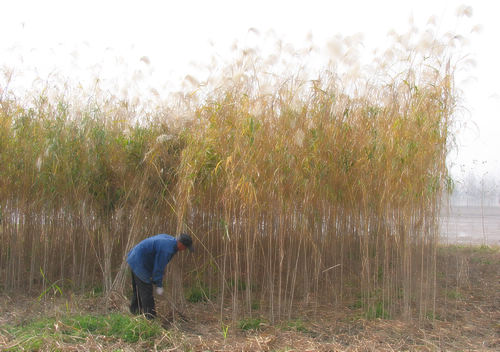摘要:第二代能源作物需在干旱、贫瘠和不适合于粮食生产的边际性土地上产生足够高的生物量,才能在发展可再生能源和缓解气候变化方面发挥重要作用。如何利用野生植物资源快速驯化培育第二代能源作物成为一个新的科学问题。
中科院武汉植物园系统与进化植物学学科组李建强研究员与植物研究所、上海生命科学研究院等单位合作,对最有可能在我国北方和西北广阔的边际性土地上大规模种植的能源作物——芒草开展了研究。该研究小组将采自全国近百个芒草自然居群种植到寒冷的北方温带草原、贫瘠干旱的黄土高原及温暖湿润的华中地区等3个试验点,发现芒草种类具有丰富的遗传变异和极强的适应性,是可供培育耐冷、耐旱和耐贫瘠的高产能源作物。
该成果已在线发表于《GCB生物能源》(Global Change Biology Bioenergy)。

人工种植的芒草居群
生物探索推荐英文原文报道:
An article in the current issue of Global Change Biology Bioenergy finds that natural populations of Miscanthus are promising candidates as second-generation energy sources because they have genetic variation that may increase their stress tolerance.
Sustainable, large-scale bioenergy production requires domestication that develops crops capable of producing sufficiently high biomass on marginal and degraded land.
Yan and coauthors collected three species of Miscanthus from populations across China and grew these species at three separate sites with varying climates to evaluate their growth. The authors found that wild populations of Miscanthus have high levels of genetic variation and adaptation that could provide valuable resources for the development of second-generation energy crops.
According to Professor Sang of the Plant Biology Department at Michigan State University, the Director of the Key Laboratory of Plant Resources at the Institute of Botany, Chinese Academy of Sciences, "The domestication of food crops began approximately ten thousand years ago, partly in response to climate change following the last glacial maximum. Today another round of domestication for energy crops may be necessary for the sustainability of our society. In this study, we found that wild Miscanthus species native to China have the potential to become high-yield energy crops capable of growing on marginal land. The domestication of Miscanthus should be an equally exciting, but much shorter, journey in comparison to food crop domestication."
Researchers are encouraged by these findings because in order for bioenergy crops to not compete with food production they will have to be grown on land with poor soil quality and little irrigation. Miscanthus continues to have potential as a bioenergy crop because of its high biomass yield in regions that are colder and drier than its natural habitats.
生物探索推荐英文原文摘要:
Variability and adaptability of Miscanthus species evaluated for energy crop domestication
Abstract
A growing body of evidence indicates that second-generation energy crops can play an important role in the development of renewable energy and the mitigation of climate change. However, dedicated energy crops have yet to be domesticated in order to fully realize their productive potential under unfavorable soil and climatic conditions. To explore the possibility of domesticating Miscanthus crops in northern China where marginal and degraded land is abundant, we conducted common garden experiments at multiple locations to evaluate variation and adaptation of three Miscanthus species that are likely to serve as the wild progenitors of the energy crops. A total of 93 populations of Miscanthus sinensis, Miscanthus sacchariflorus, and Miscanthus lutarioriparius were collected across their natural distributional ranges in China and grown in three locations that represent temperate grassland with cold winter, the semiarid Loess Plateau, and relatively warm and wet central China. Evaluated with growth traits such as plant height, tiller number, tiller diameter, and flowering time, the Miscanthus species showed high levels of genetic variation within and between species. There were significant site × population interactions for almost all traits of M. sacchariflorus and M. sinensis, but not M. lutarioriparius. The northern populations of M. sacchariflorus had the highest establishment rates at the most northern site owing to their strong cold tolerance. An endemic species in central China, M. lutarioriparius, produced not only the highest biomass of the three species but also higher biomass at the Loess Plateau than the southern site near its native habitats. These results demonstrated that the wild species harbored a high level of genetic variation underlying traits important for crop establishment and production at sites that are colder and drier than their native habitats. The natural variation and adaptive plasticity found in the Miscanthus species indicated that they could provide valuable resources for the development of second-generation energy crops.
Keywords:biomass;cold tolerance;lignocellulosic energy crops;M. lutarioriparius;M. sacchariflorus;M. sinensis







